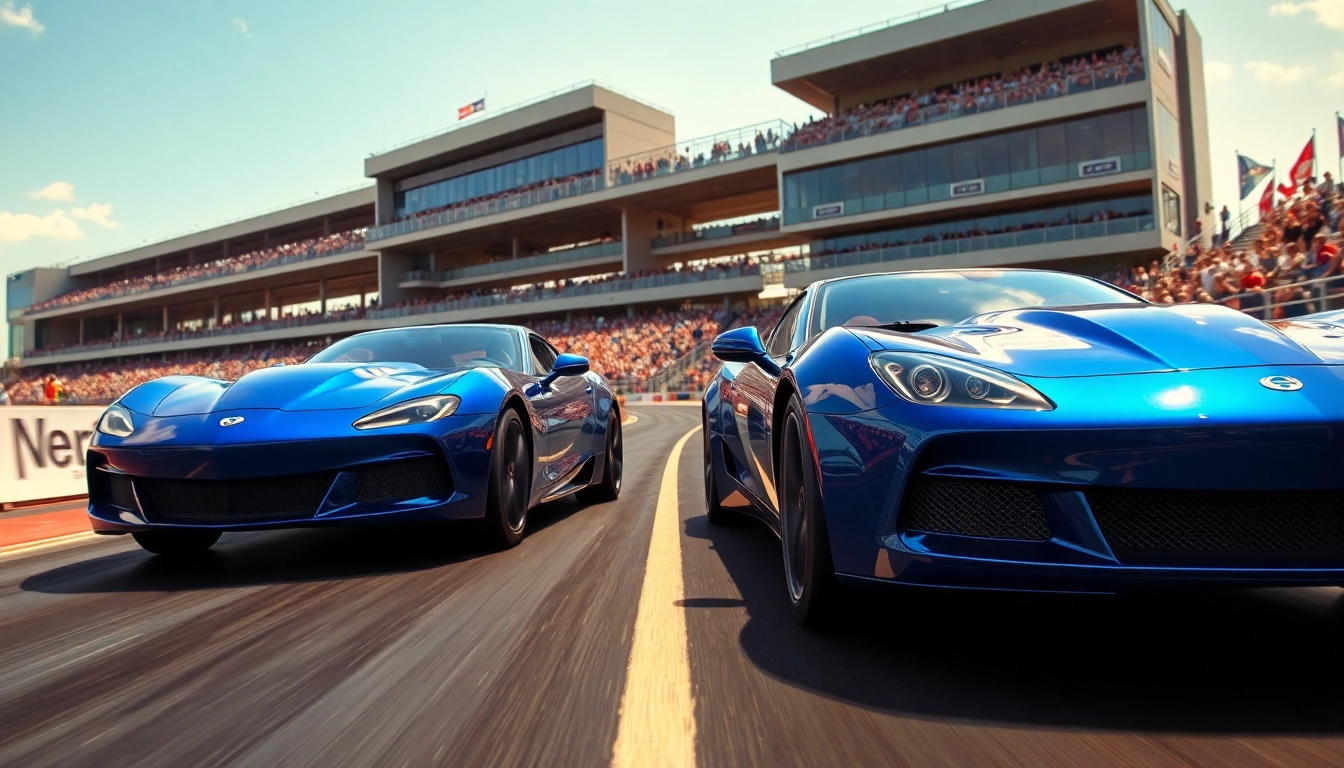Mastering the Art of Drag Racing: From Basics to Advanced Techniques
Understanding the Basics of Drag Racing
What is Drag Racing?
Drag racing is a form of Drag Racing in which cars or motorcycles compete to be the first to cross a set finish line. Often held on straight tracks called drag strips, this sport entails a race between two vehicles starting from a standing start to cover a specific distance, typically a quarter mile. Participants rely on their driving skills, vehicle performance, and sometimes a bit of luck to claim victory.
History and Evolution of Drag Racing
Originating from the early 20th century, drag racing has seen significant evolution over the decades. The sport’s roots can be traced back to informal street races in Southern California, where veterans and newcomers would compete on the roads. The rise of organized events started post World War II when veterans returned home with newfound skills and a desire for a competitive outlet.
As the sport matured, various associations were formed, including the National Hot Rod Association (NHRA) in 1951, which set standardized rules and safety regulations. This led to a boom in popularity, drawing in more participants and spectators alike. Today, drag racing encompasses a wide array of events and classes, from grassroots competitions to elite professional series, showcasing everything from household vehicles to custom-built race cars.
Types of Drag Racing Events
Drag racing events can be broadly categorized into several types:
- Bracket Racing: This is one of the most common forms of drag racing, where participants race against a pre-established time to ensure a fair competition.
- Heads-Up Racing: In this type, two racers compete against each other without any handicap—it’s purely a race to the finish.
- Pro Series: These are professional competitions governed by organizations like the NHRA, featuring highly modified vehicles and significant cash prizes.
- Street Racing: Often illegal and unsanctioned, street racing takes place on public roads, presenting safety risks and legal consequences.
Essential Equipment for Competitors
Drag Racing Vehicles: An Overview
The choice of vehicle plays a significant role in the success of any drag racer. Drag racing vehicles can range from standard street cars to specially designed dragster vehicles that are engineered for top performance. Common vehicles in the competition include:
- Modified Street Cars: These vehicles are often upgraded with performance parts such as turbochargers, nitrous systems, and enhanced suspensions to improve acceleration and speed.
- Funny Cars: These vehicles are designed primarily for drag racing, featuring a lightweight chassis and powerful engines, capable of remarkable speeds.
- Top Fuel Dragsters: These are the quickest vehicles in drag racing, powered by highly specialized engines, often exceeding 10,000 horsepower.
Safety Gear and Regulations
Safety is paramount in drag racing, and competitors are required to wear specific safety gear, including:
- Helmet: A racing helmet that meets established safety certifications is mandatory.
- Fire Suit: Designed to withstand high temperatures, fire suits protect racers from the risk of fire or burns.
- Safety Belts: Multi-point harness systems are essential to keep racers secure during high-speed races.
- Parachutes: In high-speed events, parachutes are employed to help slow vehicles after crossing the finish line.
Regulations vary by event and class, so racers must stay updated with the guidelines provided by sanctioning bodies like the NHRA.
Choosing the Right Track for Your Needs
Selecting the appropriate drag racing track is crucial not only for competitive performance but also for ensuring safety. Here are factors to consider when choosing a drag strip:
- Surface Quality: Look for tracks that maintain a well-groomed and consistent surface to avoid traction issues.
- Facilities: A good track offers essential amenities, including pit areas, restrooms, and spectator seating.
- Type and Length of Track: Ensure the track meets the requirements for your race class, particularly if you’re participating in professional events.
Techniques for Successful Drag Racing
Acceleration and Reaction Times
One of the most vital aspects of drag racing is mastering the launch and acceleration phases. Racers must develop their reaction times, which can depend on multiple factors, such as starting light patterns. A perfect launch is achieved by balancing throttle and clutch control to minimize wheel spin while achieving maximum acceleration.
Practicing methods like launching from different RPMs and adjusting tire pressures can yield significant improvements.
Vehicle Tuning Tips for Optimal Performance
Tuning is a critical element of drag racing success. Proper tuning enhances vehicle performance in several areas:
- Engine Setup: Adjusting the air-fuel mixture and timing can optimize engine output.
- Transmission Performance: Ensuring smooth gear shifts can reduce time lost during acceleration.
- Suspension Tuning: Setting up the suspension can improve traction and stability during acceleration.
Finding the right tuning balance often requires trial and error as well as data analysis from previous runs.
Understanding Track Conditions and Setup
Track conditions can greatly affect performance; thus, it’s essential to understand how temperature, humidity, and surface texture impact traction and vehicle behavior. For example, hotter tracks can provide better grip, while cooler conditions may present a challenge.
Race teams often gather data from testing runs to adjust tire pressures and launch techniques based on these conditions. Observations from previous races can significantly inform setup strategy for optimal performance.
Community and Events in Drag Racing
How to Get Involved in Drag Racing Community
Becoming a part of the drag racing community can greatly enhance the experience and offer opportunities for learning and networking. Participating in local events, joining clubs, and engaging in online forums are excellent ways to meet fellow enthusiasts and gain insights into the sport. Social media platforms also serve as great channels for connecting with drag racing communities.
Major Drag Racing Competitions to Attend
Notable drag racing events include:
- NHRA SpringNationals: A premier event that draws top competitors from around the country.
- World Series of Drag Racing: One of the oldest and most prestigious events in the drag racing calendar.
- Street Outlaws Events: These events have gained popularity through television exposure, bringing street racing to the drag racing mainstream.
Attending these events offers fans a live experience of the adrenaline, challenges, and festivities surrounding drag racing.
Online Resources for Drag Racing Enthusiasts
For those wanting to further their knowledge or even plan to participate in drag racing, numerous online platforms provide valuable resources:
- Forums: Websites like RacePages allow for community engagement and information exchange.
- YouTube Channels: Many YouTube channels offer tutorials, vehicle setup advice, and race event coverage.
- Blogs and Magazines: Publications such as Drag Illustrated and NHRA.com offer articles on trends, tips, and event coverage.
Future Trends in Drag Racing
Technological Advances in Drag Racing
As automotive technology continues to progress, drag racing is benefiting from innovations such as improved aerodynamics, advanced materials, and data analysis tools. For instance, telemetry systems allow teams to gather performance data in real-time, enabling better decision-making during races.
3D printing is increasingly used to fabricate parts, reducing costs and time while allowing for more intricate designs.
How Electric Vehicles are Changing the Scene
With the automotive industry shifting towards electrification, electric drag racing has emerged as a growing segment. Electric vehicles (EVs) are showcasing remarkable acceleration due to instant torque, with certain models competing in traditional drag racing events. Companies like Tesla and Rimac are leading the way, demonstrating that EVs can deliver impressive performance on the drag strip.
Competitions geared specifically towards electric vehicles are also expected to grow, challenging perceptions about drag racing and sustainability.
The Rise of Virtual Drag Racing Competitions
As technology advances, virtual drag racing is becoming increasingly popular, particularly amid events like the COVID-19 pandemic when physical gatherings were restricted. Online platforms allow racers to compete in simulations, drawing large audiences and fostering competitive spirits.
Virtual competitions provide an accessible entry point for new participants who might not have the resources to join traditional racing circuits. eSports events focused on drag racing are expected to continue gaining momentum, attracting professional racers and gaming enthusiasts alike.


